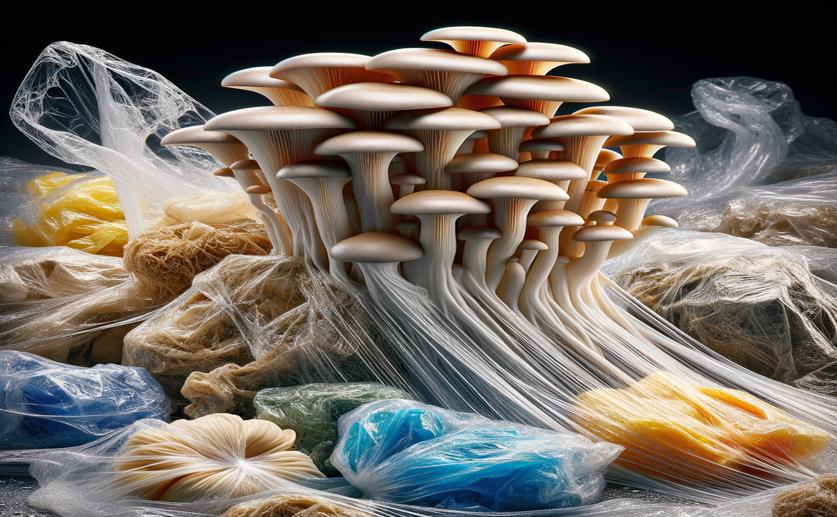Faster Breakdown of Treated and New Plastic Films by Oyster Mushrooms

Image Source: Natural Science News, 2024
Key Findings
- Researchers at the Autonomous University of Tlaxcala found that the fungus Pleurotus ostreatus can degrade low-density polyethylene (LDPE) films
- The fungus produced high levels of enzymes like laccase, lignin peroxidase, manganese peroxidase, and unspecific peroxygenase, which are crucial for breaking down LDPE
- UV radiation enhanced the biodegradation process, with UV-treated recycled LDPE showing the fastest degradation, fragmenting into pieces within five weeks
Polyethylene, a widely used petroleum-derived polymer, poses significant environmental pollution challenges due to its resistance to degradation. A recent study conducted by researchers at the Autonomous University of Tlaxcala has explored the potential of the fungus Pleurotus ostreatus to degrade both UV-treated and untreated low-density polyethylene (LDPE) films, including recycled and new samples[1]. This study aimed to investigate the fungal biomass production, enzyme production, and changes in the chemical structure and surface morphology of LDPE after fungal growth.
The researchers found that Pleurotus ostreatus produced high levels of specific enzymes, such as laccase (Lac), lignin peroxidase (LiP), manganese peroxidase (MnP), and unspecific peroxygenase (UP), during the degradation process. Notably, the highest enzyme activities were observed in UV-irradiated recycled LDPE (IrRPE) samples, with Lac reaching 6013 U/L, LiP at 2432 U/L, MnP at 995 U/L, and UP at 6671 U/L. These enzymes play a crucial role in breaking down the complex polymer structure of LDPE.
The study also examined changes in the chemical structure and surface morphology of LDPE using Fourier Transform Infrared (FTIR) spectroscopy and Scanning Electron Microscopy (SEM). The researchers observed that the contact angle of all LDPE samples decreased with longer fermentation times, indicating effective biodegradation. Specifically, the IrRPE samples exhibited the smallest contact angle (49°) at four weeks, and these samples fragmented into two pieces at five weeks. This finding suggests that UV radiation enhances the biodegradation process, making recycled LDPE degrade faster than new LDPE.
The results of this study align with previous research on the biodegradation of polyethylene by fungi. For instance, Pleurotus ostreatus has been shown to degrade oxo-biodegradable polyethylene, another type of polyethylene, after exposure to sunlight[2]. Additionally, the study on the degradation of low-density polyethylene (LDPE) by Rhizopus oryzae NS5 demonstrated the potential of fungi to adhere to and degrade polyethylene surfaces, resulting in a decrease in weight and tensile strength of the material[3].
Moreover, the study highlights the role of ligninolytic enzymes in the degradation process. Lignin peroxidase (LiP), manganese peroxidase (MnP), and laccase (Lac) are known to degrade lignin, a complex organic polymer found in plant cell walls. These enzymes have also been shown to degrade pollutants with similar structures to lignin, such as paraquat, a widely used herbicide[4]. The current study expands on this knowledge by demonstrating that these enzymes can also degrade polyethylene, a petroleum-derived polymer.
The findings of this study are significant as they provide a potential solution to the environmental pollution caused by polyethylene. The ability of Pleurotus ostreatus to degrade LDPE, especially when enhanced by UV radiation, offers a promising approach for the biodegradation of plastic waste. This process is not only efficient but also environmentally friendly, as it utilizes naturally occurring fungi and their enzymes.
In conclusion, the study conducted by the Autonomous University of Tlaxcala demonstrates the potential of Pleurotus ostreatus to degrade low-density polyethylene (LDPE) films through the production of specific enzymes. The research highlights the importance of UV radiation in enhancing the biodegradation process and provides valuable insights into the chemical and structural changes occurring in LDPE during fungal growth. These findings contribute to the growing body of knowledge on the biodegradation of plastics and offer a promising solution for mitigating environmental pollution caused by polyethylene.
SustainabilityBiochemMycology
References
Main Study
1) Enhanced degradation of phototreated recycled and unused low-density polyethylene films by Pleurotus ostreatus.
Published 24th August, 2024
Journal: World journal of microbiology & biotechnology
Issue: Vol 40, Issue 10, Aug 2024
Related Studies
Related Articles





 20th April, 2024 | Greg Howard
20th April, 2024 | Greg Howard